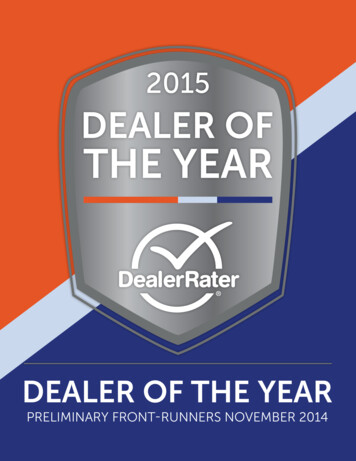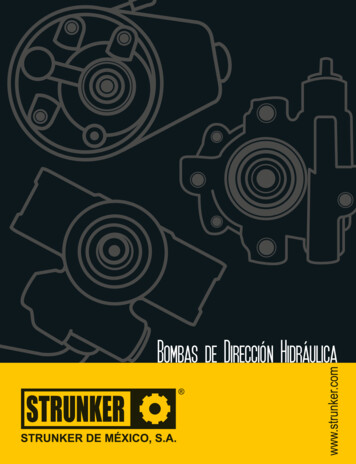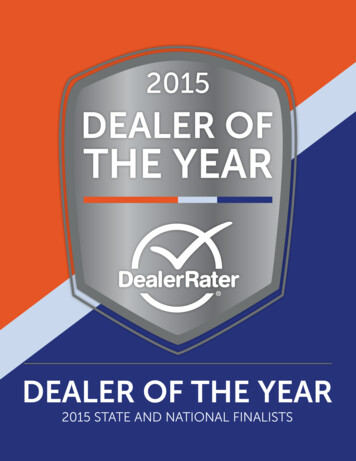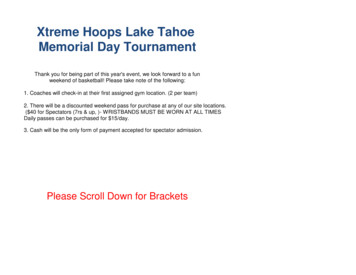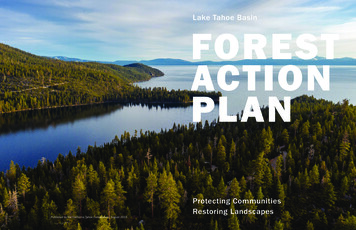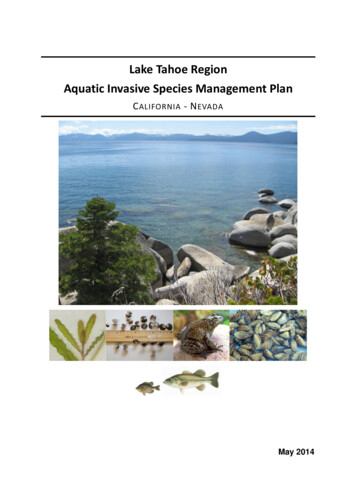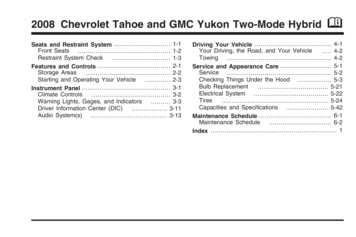
Transcription
2008 Chevrolet Tahoe and GMC Yukon Two-Mode HybridSeats and Restraint System . 1-1Front Seats . 1-2Restraint System Check . 1-3Features and Controls . 2-1Storage Areas. 2-2Starting and Operating Your Vehicle. 2-3Instrument Panel . 3-1Climate Controls. 3-2Warning Lights, Gages, and Indicators. 3-3Driver Information Center (DIC). 3-11Audio System(s) . 3-13MDriving Your Vehicle . 4-1Your Driving, the Road, and Your Vehicle. 4-2Towing. 4-2Service and Appearance Care . 5-1Service . 5-2Checking Things Under the Hood . 5-3Bulb Replacement. 5-21Electrical System . 5-22Tires. 5-24Capacities and Specifications. 5-42Maintenance Schedule . 6-1Maintenance Schedule . 6-2Index . 1
PrefaceWarranty InformationGENERAL MOTORS, GM and the GM Emblem,CHEVROLET, the CHEVROLET Emblem, GMC, theGMC Emblem, and the names TAHOE and YUKON areregistered trademarks of General Motors Corporation.Two-Mode Hybrid Specific WarrantyThe information in this manual supplements theowner manual. This manual includes the latestinformation at the time it was printed. GM reserves theright to make changes after that time without furthernotice.Keep this manual in the vehicle for quick reference.IntroductionYour hybrid SUV is designed to be more fuel efficientthan the standard SUV, which results in reduced carbondioxide emissions.Litho in U.S.A.Part No. 15118085 A First PrintingiiThis information supersedes the Hybrid SpecificWarranty found in the Limited Warranty and OwnerAssistance Information booklet furnished with yournew vehicle.For vehicles sold in the United States, in addition to theBumper-to-Bumper Coverage described in the LimitedWarranty and Owner Assistance manual, General Motorswill warrant certain Hybrid components for each2008 Chevrolet Tahoe Two-Mode Hybrid and GMCYukon Two-Mode Hybrid (hereafter referred to as Hybrid)for 8 years or 100,000 miles (160 000 kilometres),whichever comes first, from the original in-service date ofthe vehicle, against warrantable repairs to the specificHybrid components of the vehicle. 2007 General Motors Corporation. All Rights Reserved.
For vehicles sold in Canada, in addition to the CompleteVehicle Coverage described in the GM Canadian LimitedWarranty, Maintenance and Owner Assistance booklet,General Motors of Canada Limited will warrant certainHybrid components for each 2008 Chevrolet TahoeTwo-Mode Hybrid and GMC Yukon Two-Mode Hybrid(hereafter referred to as Hybrid) for 8 years, or160,000 kilometres, whichever comes first, from theoriginal in-service date of the vehicle, against warrantablerepairs to the specific Hybrid components of the vehicle.What is CoveredThis warranty is for Hybrid vehicles registered in theUnited States or Canada, and normally operated in theUnited States or Canada. In addition to the initial owner ofthe vehicle, the coverage described in this Hybridwarranty is transferable at no cost to any subsequentperson(s) who assumes ownership of the vehiclewithin the above described 8 years or 100,000 mile(160 000 kilometres) term. No deductibles are associatedwith this Hybrid warranty.BrakesThis Hybrid warranty is in addition to the expressconditions and warranties described in the LimitedWarranty and Owner Assistance manual. The coverageand benefits described under “New Vehicle LimitedWarranty” are not extended or altered because of thisspecial Hybrid Component Warranty.For 2008 Hybrid owners requiring more comprehensivecoverage than that provided under this Hybrid warranty, aGM Protection Plan may be available. See your dealer formore details.This Hybrid warranty covers repairs to correct anyvehicle defect related to materials or workmanshipoccurring during the 8 year or 100,000 miles(160 000 kilometres) term for the following:TransmissionAutomatic transmission components including thetransmission auxiliary fluid pump, transmission auxiliarypump controller, and 3 phase transmission cables.Brake modulator.Other Hybrid ComponentsBattery pack, 300v cables, Drive Motor/GeneratorControl Module (DMCM) and Accessory Power Module.TowingDuring the 8 year or 100,000 mile (160 000 kilometres)Hybrid warranty period, towing is covered to the nearestservicing dealer if your vehicle cannot be driven becauseof a warranted defect. Contact the Roadside AssistanceCenter for towing. Refer to the owner manual for details.Roadside Assistance is not part of or included in thecoverage provided by the new Vehicle Limited Warranty.General Motors and General Motors of Canada Limitedreserve the right to make any changes or discontinue theRoadside Assistance program at any time withoutnotification.iii
Courtesy TransportationMaintenanceDuring the 8 year or 100,000 mile (160 000 kilometres)Hybrid warranty period, interim transportation is availableunder the Courtesy Transportation Program. Consult yourdealer for details.As the vehicle owner, you are responsible for theperformance of the scheduled maintenance listed in yourowner manual. Maintenance intervals, checks,inspections, and recommended fluids and lubricants asprescribed in the owner manual are necessary to keepyour vehicle in good working condition. Any damagecaused by owner/lessee failure to follow scheduledmaintenance may not be covered by warranty. Scheduledmaintenance includes such items as: Brake Pads/Linings Coolants and Fluids FiltersCourtesy Transportation is not a part of the New VehicleLimited Warranty. The Limited Warranty and OwnerAssistance Information booklet furnished with the vehicleprovides detailed warranty coverage information.General Motors reserves the right to unilaterally modify,change, or discontinue Courtesy Transportation at anytime and to resolve all questions of claim eligibilitypursuant to the terms and conditions described herein atits sole discretion.What is Not CoveredIn addition to the “What is Not Covered” section of thewarranty booklet, this Hybrid warranty does not cover thefollowing items:Wear ItemsWear items, such as brake linings, are not covered inthis Hybrid warranty.ivUsing this SupplementThis supplement contains information specific to thehybrid components of the vehicle. It does not explaineverything you need to know about the vehicle.Read this supplement along with the owner manual tolearn about the vehicle’s features and controls.IndexA good place to look for what you need is the Index inback of this supplement. It is an alphabetical list ofwhat is in the supplement, and the page number whereyou will find it.
Section 1Seats and Restraint SystemFront Seats .1-2Power Seats .1-2Manual Lumbar .1-2Manual Reclining Seatback .1-2Restraint System Check .1-3Replacing Restraint System Parts After aCrash .1-31-1
Front SeatsPower SeatsYour vehicle may have additional features to adjust yourvehicle’s power seat: Raise or lower the front part of the seat cushion bymoving the front of the control up or down. Raise or lower the entire seat by moving the entirecontrol up or down.Manual LumbarIncrease or decrease lumbar support by turning thecontrol (B) forward or rearward.Manual Reclining SeatbackA. Power Seat Adjustment ControlB. Manual Lumbar ControlC. Manual Reclining Seatback LeverAdjust the seat forward or rearward by sliding thecontrol (A) forward or rearward.1-2To recline the seatback:1. Lift the reclining seatback lever (C).2. Move the seatback to the desired position, thenrelease the lever to lock the seatback in place3. Push and pull on the seatback to make sure it islocked.
To return the seatback to an upright position:1. Lift the lever fully without applying pressure to theseatback and the seatback will return to theupright position.2. Release the lever to lock the seatback in place.3. Push and pull on the seatback to make sureit is locked.Restraint System CheckReplacing Restraint System PartsAfter a CrashIf an airbag inflates or the vehicle has been in a crash,the vehicle’s sensing system may command theautomatic hybrid battery disconnect to open. The batterywill disconnect. The hybrid battery will be off and thevehicle will not start. The airbag readiness light and/orSERVICE HYBRID SYSTEM message may come on inthe driver information center. See “Airbag ReadinessLight” in the owner manual and Driver Information Center(DIC) on page 3-11 for more information.To operate the vehicle, the automatic hybrid batterydisconnect must be reconnected by a qualified servicetechnician and sensing system parts will need to bereplaced. Have the vehicle serviced right away.1-3
NOTES1-4
Section 2Features and ControlsStorage Areas .2-2Power Outlet Alternating Current .2-2Starting and Operating Your Vehicle .2-3Starting Your Vehicle .2-3Automatic Transmission Operation .2-6Regenerative Braking .2-9Running the Vehicle While Parked .2-102-1
Storage AreasThe indicator light does not come on when the ignitionis in LOCK/OFF or if no equipment is plugged intothe outlet.Power Outlet Alternating CurrentYour vehicle may have a power outlet that can be usedto plug in electrical equipment that uses a maximumlimit of 150 watts.The power outlet is locatedin the rear cargo area onthe driver side.If you try to connect equipment using more than150 watts or a system fault is detected, a protectioncircuit shuts off the power supply and the indicator lightturns off. To reset the circuit, unplug the item and plug itback in or turn the Retained Accessory Power (RAP) offand then back on. The power restarts when equipmentusing 150 watts or less is plugged into the outlet and asystem fault is not detected.The power outlet is not designed for the followingelectrical equipment and may not work properly if theseitems are plugged into the power outlet: Equipment with high initial peak wattage such as:compressor-driven refrigerators and electricpower tools. Other equipment requiring an extremely stablepower supply such as: microcomputer-controlledelectric blankets, touch sensor lamps, etc.An indicator light on the outlet turns on to show it is inuse. The light comes on when the ignition is in ON/RUNand equipment requiring less than 150 watts isplugged into the outlet, and no system fault is detected.2-2See High Voltage Devices and Wiring on page 5-3.
Starting and Operating YourVehicle(Continued)Because your vehicle has the Automatic EngineStart/Stop feature, the vehicle’s engine mightseem to be shut off when you come to acomplete stop. However, once the brake pedalis released, the vehicle can move. The vehicle’sengine can also restart at any time.Starting Your Vehicle{CAUTION:Exiting your vehicle, without first shifting intoPARK (P), may cause the vehicle to move,and you or others can be seriously injured.CAUTION:CAUTION:(Continued)Shift to PARK (P) and turn the ignition toLOCK/OFF, before exiting the vehicle.Start the engine as you would any other engine. See“Starting Your Engine” in the owner manual for moreinformation on starting. The hybrid system provides veryquiet engine starting. If pulling a trailer with trailer brakes,see Towing a Trailer on page 4-2 for more information.2-3
Auto StopThe vehicle has an Auto Stop feature. After a successfulengine start, the Hybrid Powertrain Control Module(HPCM) may turn off the engine and operate in the AutoStop mode. Some of the vehicle conditions that allow theengine to stop running and enter the Auto Stop mode are: Ignition switch is in the ON/RUN position. The hood is closed. The gear selector is in PARK (P), NEUTRAL (N) orDRIVE (D). The hybrid battery is at an acceptable state ofcharge. The hybrid battery voltage, temperature or powerlimits are not exceeded. In very hot conditions, AutoStop may be unavailable until the hybrid battery hascooled. The engine is at operating temperature.If you are on an incline, the hybrid drive motor can helpkeep your vehicle from rolling backwards, even if theengine is in Auto Stop.2-4With your foot off the brake and the vehicle on levelground, the hybrid drive motor may cause your vehicle toroll slowly forward, even when the engine is in Auto Stop.To be sure your vehicle will not move or roll, alwayskeep your foot firmly on the brake pedal until youare ready for the vehicle to move.Engine OFF and AUTO STOP modes are indicated onthe tachometer display. When the tachometer needleindicates OFF, the engine is not running and will remainoff until the ignition key is placed in the START position ora remote vehicle start is performed. When the tachometerneedle indicates AUTO STOP, the engine is not runningbut may Auto Start at any time without notice. SeeTachometer on page 3-4 for more information.A chime will sound if the driver door is opened while inAuto Stop as a reminder that the ignition switch is not inthe LOCK/OFF position. Always turn the ignition switch toLOCK/OFF and remove the key from the ignition switchwhen exiting the vehicle.
Auto StartEV ModeThe vehicle also has an Auto Start feature. The enginewill remain off while in Auto Stop mode until vehicleconditions require the engine to run. The near-instantstarting of the engine from Auto Stop mode is calledAuto Start. Some of the vehicle conditions thatmay cause the HPCM to Auto Start the engine are:The vehicle also has an EV mode which uses only theelectric motor to move the vehicle. Depending onthe state of battery charge, the vehicle can travel up totwo miles in EV mode. EV mode is unavailable whenthe vehicle is out of fuel. The hood is opened. The gear selector is in MANUAL MODE (M) orREVERSE (R). The hybrid battery state of charge is too low. The hybrid battery voltage, temperature or powerlimits are exceeded. The engine is not at operating temperature. Acceleration demands require the use of the engine.While lightly accelerating, the vehicle will be propelled inEV mode.If increased acceleration is required, or the vehicleachieves a speed of approximately 25 mph (40 km/h),the engine will start automatically. The engine willshut off at speeds below 25 MPH (40 km/h) unless thetransmission is in MANUAL MODE (M) or Auto Stopis disabled.During heavy acceleration, both the engine and hybridelectric motors supply power. A sensation similar to atransmission gear change can be felt as the transmissionchanges modes. Engine RPM may remain above4,000 RPM for a longer period during hard acceleration.2-5
Automatic Transmission OperationYour vehicle has an M99–EVT transmission, and has anelectronic shift position indicator within the instrumentpanel cluster. The electronic shift position indicatordisplays when the shift lever is moved out of PARK (P).There are several different positions for the shift lever.See ““Range Selection Mode” later in this section.PARK (P): This position locks the rear wheels. It is thebest position to use when you start your enginebecause the vehicle cannot move easily.When parked on a hill, especially when the vehicle has aheavy load, you may notice an increase in the effort toshift out of PARK (P). See “Shifting Into PARK (P)” in theIndex of vehicle’s owner manual for more information.2-6{CAUTION:It is dangerous to get out of your vehicle if theshift lever is not fully in PARK (P) with theparking brake firmly set. Your vehicle can roll.Do not leave your vehicle when the engine isrunning unless you have to. If you have left theengine running, the vehicle can move suddenly.You or others could be injured. To be sure yourvehicle will not move, even when you are onfairly level ground, always set your parkingbrake and move the shift lever to PARK (P).See “Shifting Into Park (P)” in the OwnerManual.If you are pulling a trailer, see Towing a Traileron page 4-2.REVERSE (R): Use this gear to back up.Notice: Shifting to REVERSE (R) while your vehicleis moving forward could damage the transmission.The repairs would not be covered by your warranty.Shift to REVERSE (R) only after your vehicle isstopped.
To rock your vehicle back and forth to get out of snow,ice, or sand without damaging the transmission, see“If Your Vehicle is Stuck in Sand, Mud, Ice, or Snow” inthe Index of the vehicle’s owner manual.NEUTRAL (N): In this position, the engine andtransmission are not connected with the wheels. Torestart while the vehicle is already moving, useNEUTRAL (N) only.{CAUTION:Shifting into a drive gear while the engine isrunning at high speed is dangerous. Unlessyour foot is firmly on the brake pedal, yourvehicle could move very rapidly. You couldlose control and hit people or objects. Do notshift into a drive gear while your engine isrunning at high speed.DRIVE (D): This position is for normal driving. Itprovides the best fuel economy for your vehicle. If youneed more power for passing, and you are: Going less than about 35 mph (55 km/h), push theaccelerator pedal about halfway down. Going about 35 mph (55 km/h) or more, push theaccelerator all the way down.DRIVE (D) can be used when towing a trailer, carrying aheavy load, driving on steep hills, or for off-roaddriving. You may want to shift the transmission to alower gear selection if the transmission shifts too often.Downshifting the transmission in slippery roadconditions could result in skidding, see “Skidding” under“Loss of Control” in the Index of the vehicle’s ownermanual.When temperatures are very cold, the transmission’sgear shifting may be delayed providing more stableshifts until the engine warms up. Shifts may be morenoticeable with a cold transmission. This differencein shifting is normal.Notice: Shifting out of PARK (P) or NEUTRAL (N)with the engine running at high speed may damagethe transmission. The repairs would not be coveredby your warranty. Be sure the engine is not runningat high speed when shifting your vehicle.2-7
MANUAL MODE (M): This position lets drivers selectthe range of gears appropriate for current drivingconditions. If your vehicle has this feature, see “RangeSelection Mode” later in this section.Range Selection ModeNotice: Spinning the tires or holding the vehicle inone place on a hill using only the acceleratorpedal may damage the transmission. The repair willnot be covered by your warranty. If you are stuck,do not spin the tires. When stopping on a hill,use the brakes to hold the vehicle in place.Your vehicle has a shift stabilization feature that adjuststhe transmission shifting to the current driving conditionsin order to reduce rapid upshifts and downshifts. This shiftstabilization feature is designed to determine, beforemaking an upshift, if the engine will be able to maintainvehicle speed by analyzing things such as throttleposition, vehicle load, and hill grade. If the shiftstabilization feature determines that a current vehiclespeed cannot be maintained, the transmission does notupshift and instead holds the current gear. In somecases, this may appear to be a delayed shift, however thetransmission is operating normally.The Range Selection Mode controls the vehicle’stransmission.To use this feature, do the following:1. Move the shift lever to the MANUAL MODE (M).2. Press the plus/minus button, to upshift or downshiftselecting the desired range of gears for your currentdriving conditions.2-8
While in the MANUAL MODE (M) a number displays nextto the M, indicating the current gear that has beenselected. The number displayed in the gear indicator isthe highest gear that can be used. However, your vehiclecan automatically shift to lower gears as it adjusts todriving conditions. This means that all gears below thatnumber are available. When THIRD (3) is selected,FIRST (1) through THIRD (3) gears are automaticallyshifted by the vehicle, but FOURTH (4) cannot be useduntil the plus/minus button located on the steering columnlever is used to change to the gear.Pushing the minus ( ) button on the shift lever willchange the gear range to M1. In this gear range,effective engine braking will occur at speeds above10 mph (16km/h).The Range Selection Mode controls the vehicle andengine speed while driving down a hill or towing a trailer,by allowing you to select a desired range of gears.Regenerative BrakingWhen you move the shift lever into M, the transmissionwill default to M4. In this gear range, effective enginebraking will occur at speeds above 45 mph (72 km/h).Pushing the minus ( ) button on the shift lever willchange the gear range to M3. In this gear range,effective engine braking will occur at speeds above35 mph (56 km/h).Pushing the minus ( ) button on the shift lever willchange the gear range to M2. In this gear range,effective engine braking will occur at speeds above25 mph (40 km/h).When operating in MANUAL MODE (M), Auto Stop isdisabled. Vehicle efficiency is decreased operatingin MANUAL MODE (M) compared to DRIVE (D).Cruise control can be used while using the RangeSelection Mode.Your vehicle uses a hybrid technology known asregenerative braking. This technology enables theelectric drive motor on your vehicle to operate asa generator when you are coasting or braking. Theenergy of the moving vehicle is used to recharge thevehicle’s high voltage hybrid battery.The conventional hydraulic disc brakes on your vehiclework in partnership with the regenerative braking toinsure effective braking in all situations, such as when thehigh voltage hybrid battery is fully charged or a highbraking demand is requested. Four wheel, four channelABS allows the vehicle to maintain steering control duringbraking and Electronic Stability Control (ESC) helps youto keep your vehicle in control in unfavorable conditions.These systems, however, are not a substitute for safedriving practices.2-9
The braking system is computer controlled and uses theinformation provided by the driver’s input at the brakepedal to seamlessly blend the regenerative braking withthe conventional hydraulic disc brakes to meet anyrequirements for deceleration. The brake controller inyour vehicle has a high pressure accumulator to providethe hydraulic pressure to the disc brakes in response tothe driver’s input. The controller interprets the brakingrequest and uses regenerative braking, conventionalhydraulic braking or a combination of both as necessary.Since the controller applies the hydraulic brakes throughits high pressure accumulator, you may occasionally hearthe motor driven pump in the controller when it runs torecharge the system. This recharging cycle is normal.Even though the conventional disc brakes are operatedby the controller, there is still a direct mechanicalconnection with the brake pedal and the hydraulic brakesystem in the unlikely event of a controller problem. See“Warning Lights, Gages, and Indicators” and “DriverInformation Center (DIC)” in the Index of the vehicle’sowner manual. In the event of a controller problem, yourbrake pedal may be harder to push and the stoppingdistance may be longer.Running the Vehicle While ParkedIt is better not to park with the engine running. But if youever have to, here are some things to know.{CAUTION:Exiting your vehicle, without first shifting intoPARK (P), may cause the vehicle to move, andyou or others can be seriously injured.Because your vehicle has the Automatic EngineStart/Stop feature, the vehicle’s engine mightseem to be shut off when you come to acomplete stop. However, once the brake pedalis released, the vehicle can move. The vehicle’sengine can also restart at any time.Shift to PARK (P) and turn the ignition toLOCK/OFF, before exiting the vehicle.Follow the proper steps to be sure your vehicle will notmove. See “Shifting Into PARK (P)” in the owner manualfor more information.If you are pulling a trailer, see Towing a Trailer onpage 4-2 for more information.2-10
Section 3Instrument PanelClimate Controls .3-2Warning Lights, Gages, and Indicators .3-3Instrument Panel Cluster .3-3Tachometer .3-4Charging System Light .3-4Fuel Economy Gage .3-5Brake System Warning Light .3-5Anti-lock Brake System (ABS) Warning Light .3-6StabiliTrak Indicator Light .3-7Engine Coolant Temperature Gage .3-7Oil Pressure Gage .3-8Oil Pressure Light .3-9Fuel Gage .3-10Driver Information Center (DIC) .3-11DIC Warnings and Messages .3-11Audio System(s) .3-13Navigation/Radio System .3-133-1
Climate ControlsFor more information on the vehicle’s climate controlsystem, see “Climate Control System” in the ownermanual Index.Electric Air Conditioning CompressorThis hybrid vehicle has a 300 volt, electrically poweredair conditioning compressor. This allows for continuousair conditioning operation and passenger comfort,even while the hybrid engine cycles on and off.3-2When operating the climate control system, select theAUTO mode and the desired temperature setting.The climate control system will automatically adjust thefan speed and airflow direction. The climate controlsystem continues to adjust the climate control settingschosen for best use of electrical power.To get maximum engine off time, select a warmertemperature setting or turn off the air conditioning toshut off the compressor. Continuous air conditioning usecan cause the engine to autostart more frequently.Some noise may be heard occasionally from thecompressor, especially when air conditioning use is highand the engine has turned off.
Warning Lights, Gages, and IndicatorsInstrument Panel ClusterUnited States version shown, Canada similarThe instrument cluster is designed to let you know at a glance how your vehicle is running. You will know how fastyou are going, about how much fuel you have, and many other things you will need to know to drive safely andeconomically.3-3
TachometerCharging System LightThis light will come onbriefly when you turn onthe ignition toACC/ACCESSORY orON/RUN, but the engine isnot running, as a checkto show you it is working.United States versionshown, Canada similarWhen the gas engine is off and the key is in the ON/RUNposition, the tachometer indicates the state of the vehicle: AUTO STOP position indicates that the vehicle is stillable to move and the engine could restart, by anAuto Start, at any time. OFF position indicates that either the vehicle wasturned off or the engine has stalled.When the engine is on, the Tachometer indicates theengine’s revolutions per minute.3-4It should go out once the engine has been started. If itstays on, or comes on while driving, there could be aproblem with the charging system. A charging systemDriver Information Center (DIC) message may alsoappear. See DIC Warnings and Messages on page 3-11for more information. This light could indicate that thereare electrical problems. Have it checked right away. If youmust drive a short distance with the light on, be certain toturn off all the accessories, such as the radio and airconditioner.
Fuel Economy GageBrake System Warning LightWith the ignition in ON/RUN, the brake system warninglight will come on when you set the parking brake. If youtry to drive with the parking brake engaged, a chimewill sound when the vehicle speed is greater than5 mph (8 km/h).Your vehicle’s hydraulic brake system is divided into twoparts. If one part is not working, the other part canstill work and stop you. For good braking, though, youneed both parts working well.United StatesCanadaIf the warning light comes on and a chime sounds therecould be a brake problem. Have your brake systeminspected right away.This gage shows when the vehicle is operating at a fuelefficient point.By modifying your driving behavior to increase theeconomy time during driving, your fuel mileage will beimproved. When driving in a way that increases the fueleconomy, the indicator moves into the high efficiencyband. When driving in a way that decreases fueleconomy, the indicator moves into the less efficient band.There are several zones on the gage, indicating severallevels of efficiency when accelerating or decelerating.3-5
This light may also come on due to low brake fluid. Seeyour owners manual for more information.If the light comes on while you are driving, pull off theroad and stop carefully. You may notice that the pedal isharder to push or may go closer to the floor. It may takelonger to stop. If the light is still on, have the vehicletowed for service. See Towing Your Vehicle on page 4-2.Anti-lock Brake System (ABS)Warning LightUnited StatesCanadaThis light should come on briefly when you turn theignition key to ON/RUN. If it does not come on then,ha
Warranty" are not extended or altered because of this special Hybrid Component Warranty. For 2008 Hybrid owners requiring more comprehensive coverage than that provided under this Hybrid warranty, a GM Protection Plan may be available. See your dealer for more details. What is Covered This Hybrid warranty covers repairs to correct any
